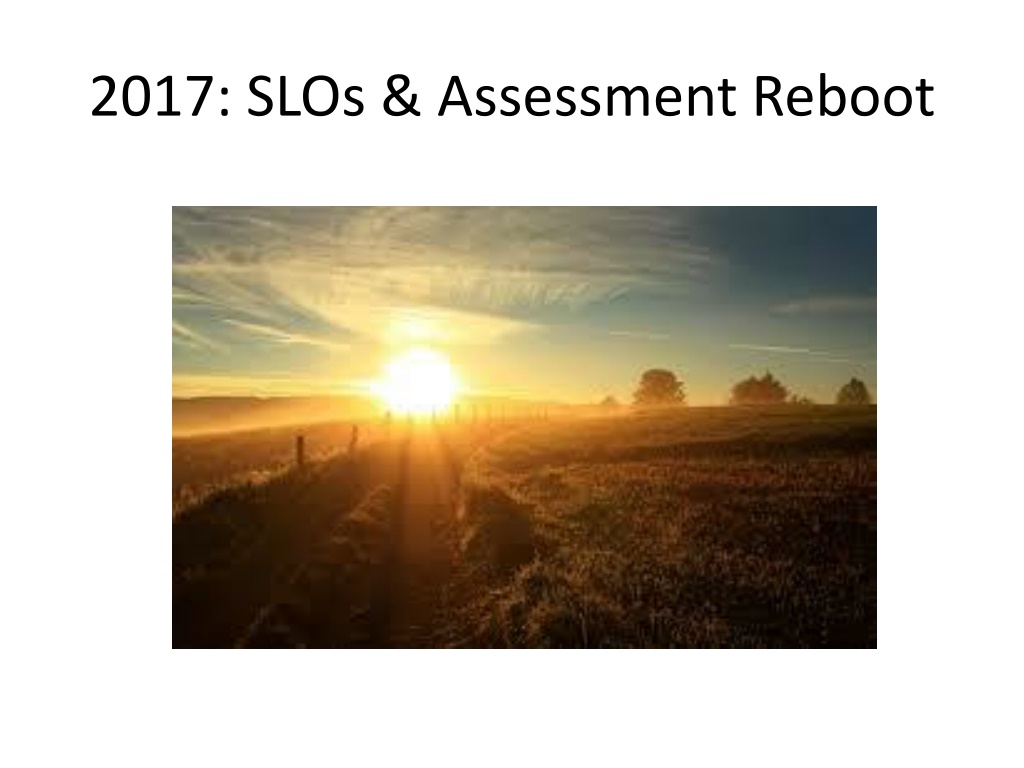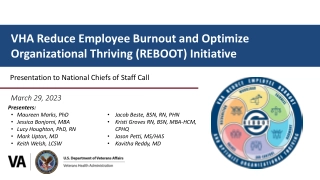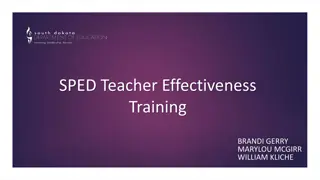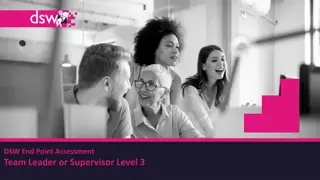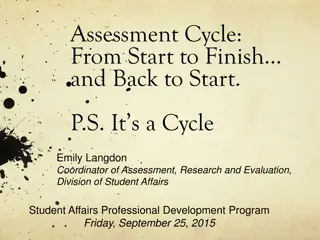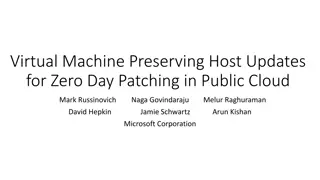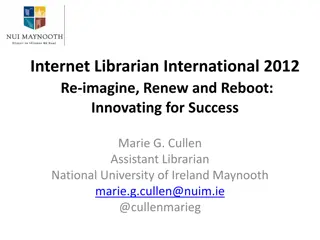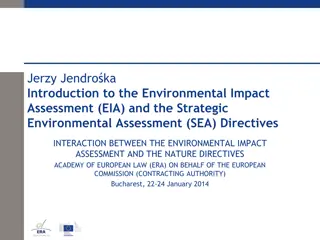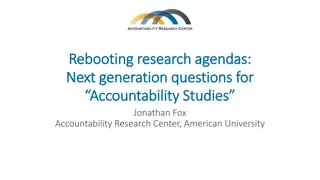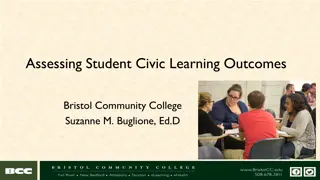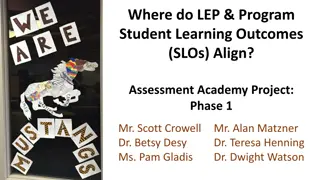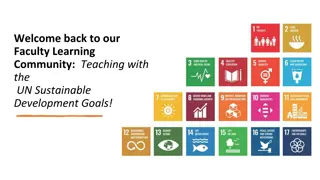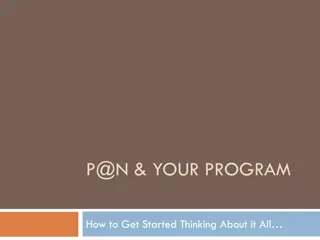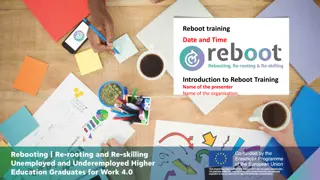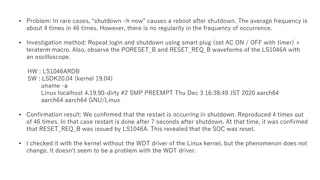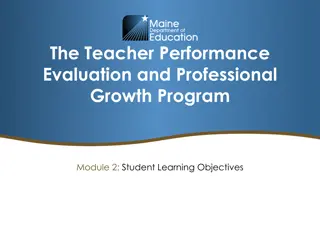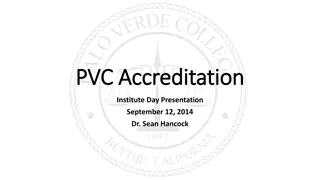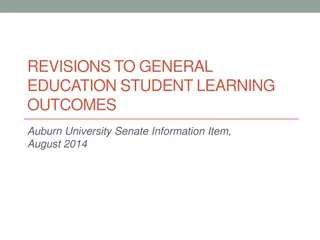2017: SLOs & Assessment Reboot
"Rebooting SLOs and assessment process to meet faculty dissatisfaction and regulatory requirements. ACCJC mandates evidence-based assessment cycle for student learning outcomes. Discussing learning outcomes, policies, and faculty concerns."
Download Presentation

Please find below an Image/Link to download the presentation.
The content on the website is provided AS IS for your information and personal use only. It may not be sold, licensed, or shared on other websites without obtaining consent from the author.If you encounter any issues during the download, it is possible that the publisher has removed the file from their server.
You are allowed to download the files provided on this website for personal or commercial use, subject to the condition that they are used lawfully. All files are the property of their respective owners.
The content on the website is provided AS IS for your information and personal use only. It may not be sold, licensed, or shared on other websites without obtaining consent from the author.
E N D
Presentation Transcript
Because - 1. Faculty don t like what we re doing now for SLO assessment What are the rules? Why are we doing this anyway? I hate Tracdat Our SLO assessment doesn t focus on the most important students or issues Not every desirable outcome can be measured! SLOs don t add any new information to what we already know I have to hassle other faculty for their data
And because - We need to comply with current ACCJC requirements.
WHAT ACCJC WANTS An evidence-based cycle of assessment. STEP ONE: Gather disaggregatable data Course grades Rates of retention Rates of transfer Rates of persistence Rates of success Evidence of student learning (SLOs) at the course, program and institutional level
WHAT ACCJC WANTS An evidence-based cycle of assessment. STEP TWO: Analyze the data at the course, program and institutional level
Creating policies TODAY S DISCUSSION: We are beginning a conversation on these questions: Question #1: What are learning outcomes? Question #2: What are student learning outcomes for? Question #3: Where should we have college-wide policies, and where should we do our own thing?
Question One: What are learning outcomes?
#1: What are learning outcomes? Student learning outcomes statements clearly state the expected knowledge, skills, attitudes, competencies, and habits of mind that students are expected to acquire at an institution of higher education. From the National Institute for Learning Outcomes Assessment
#1: Are learning outcomes like course objectives? These learning outcomes follow exactly the same rules as course objectives. Magic dust from Bloom s taxonomy of verbs differentiates between different levels of skill, and links SLOs to GE / program SLOs. BIOL 110 General Principles of Biology Explain the principles of evolution that underlie all of biology. Describe relationships and dynamics in ecosystems. Relate molecular structure and function in cells and organisms. Describe the diversity of organisms. Follow instructions, work cooperatively using appropriate laboratory skills and the scientific method to investigate biological phenomena, evaluate current issues and solve both quantitative and conceptual problems in Biology.
#1: Can learning outcomes be expressed as specific tasks? The SLO below describes the specific thing that successful students should be able to do, rather than the knowledge and skills. General Education SLO: Students can express ideas and provide supporting evidence effectively in writing and in speaking. Working independently, students can research and write a coherent, evidence- based ten-page argument, clearly written and correctly cited
#1: Or, can learning outcomes be expressed as specific achievements? Students will demonstrate the ability to obtain 75% correct (passing grade) on the practical section of the State of California Board of Barbering and Cosmetology licensing exam. Another concrete outcome. (Though more concrete would be Students will obtain 75% correct (passing grade) on the exam. ) (from the Cosmetology Program SLOs)
#1: Perhaps SLOs summarize, and course objectives set out details? (fictional) course objective for critical thinking Students can Complete independent research Evaluate sources Identify logical gaps and errors in experimental and empirical studies, written arguments, and visual arguments (documentaries, advertizing etc.) Identify elements of rhetoric and distinguish these from logical support Write organized, complex, text-based arguments with relevant and sufficient evidence (etc.) SLO for critical thinking Students can develop and evaluate sound arguments. This summarizes all the skills laid out in the course outlines, and connects them to program and general education goals.
So: Question One - What are student learning outcomes? Rehashed course objectives? Summaries of course objectives that connect to program and GE slos? Specific tasks students should be able to do? Specific goals students should achieve? Something else?
Question Two: What are SLOs for?
Question #2: What are SLOs for? "The overriding purpose of assessment is to understand how educational programs are working and to determine whether they are contributing to student growth and development. Palomba and Banta (1999)
Question #2: What are SLOs for? retention persistence graduation transfer success in external certificates / board exams (i.e., Cosmetology etc.) student satisfaction surveys grades SLOs?
Question #2: What are SLOs for? What unique information comes from student learning outcomes assessment?
Question #2: What are SLOs for? SLO assessments can show us Strengths and weaknesses behind the grades; Program coherence; Grade inflation; Whether skills and abilities carry over between and across disciplines, courses and services.
So, Question Two: What are SLOs for? To find patterns of strength and weaknesses? To promote program coherence? To keep our grades honest? To see if students retain skills once they leave the classroom, lab, or office? Something else .?
Question #3: Where should we have college-wide policies, and where should we do our own thing?
Question #3: Where should we have college-wide policies, and where should we do our own thing? Where we must pull together: Disaggregating data Assessing General Education SLOs Setting a college target success rate for SLOs
Question #3: Where should we have college-wide policies, and where should we do our own thing? Where we might pull together: Sharing assessments across sections, courses, disciplines (e.g., ePortfolios, exit exams, capstone assignments) Common assessment calendar for the college Common purpose for assessment (see Q #2)
Question #3: Where should we have college-wide policies, and where should we do our own thing? Where we should probably do our own thing: Assessment methods (discipline and service- area specific) Target success rates
So, Question Three: Where should we have college-wide policies, and where should we do our own thing? In assessment methods? In assessment procedures? In assessment targets? Somewhere else?
YOUR TASK: Thinking of how this will play out in your discipline or service area, brainstorm your responses to these questions! Question #1: What are learning outcomes? Question #2: What are SLOs for? Question #3: Where should we have college-wide policies, and where should we do our own thing?
